
by Rick O'Connor | Sep 19, 2015
I am not going to lie… I skipped August… It was hot…
September however was nice. The day I made the hike the skies were clear and the temperature was 75°F! wonderfully… truly wonderful.
If you are like me you probably begin your day around the same time – and have probably noticed that it is darker when you get up. September 22 is the fall equinox and the length of our day will be exactly 12 hours of daylight and 12 hours of darkness. We then enter the “dark side” of the calendar year – the days will become shorter… and already have. As we move into autumn on our beaches we will notice some changes. One, fewer visitors, but we will also notice changes in wildlife.

The steep incline of a winter time beach scarp.
Photo: Molly O’Connor

The remnants of moon jellyfish near a ghost crab hole.
Photo: Rick O’Connor

Many counties in the panhandle have lighting and barrier ordinances to protect wildlife and workers.
Photo: Rick O’Connor
As you can see in the photograph the scarp of the shoreline is becoming more pronounced. As the sun begins to spend more time below the horizon the winds shift, the waves change, sand is moved more offshore and the shape of our beach changes as well. You may have noticed the purple safety flags have been flying a lot recently. These mean “dangerous sea life” and we have been seeing a lot of jellyfish as the summer comes to a close. Today I noticed a lot of ghost crab holes. These guys are always around but their presence seems more noticeable this time of year – possibly due to more available food. Over the last six months I have been working with CleanPeace and the Escambia County Division of Marine Resources monitoring marine debris. Our objective is to determine what the major local debris issues are and develop an education program to try and reduce these problems. Cigarette butts have been consistently the #1 item since January. Many of you probably remember the “Keep Your Butt off the Beach” campaign a few years back… apparently did not worked well. We will have to educate locals and visitors to please take their cigarette butts with them. For those in Escambia County you will now notice the new Leave No Trace signs. The Escambia County Board of County Commissioners passed a new ordinance this past month that requires all residents and visitors to remove items from the beach overnight. Not only have these negatively impacted nesting sea turtles they have become a hazard for evening work crews and the general public. Most panhandle counties have some form of “Leave No Trace”. Please help educate everyone about their ordinances.
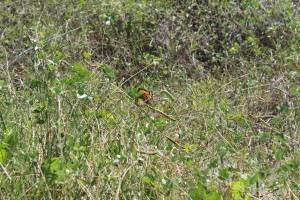
The majestic monarch butterfly stopping along the panhandle on its way to Mexico.
Photo: Molly O’Connor
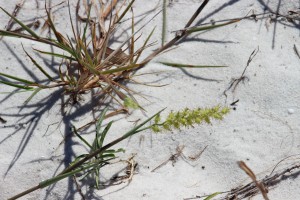
The common sandspur.
Photo: Molly O’Connor
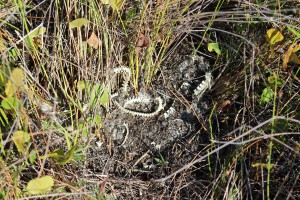
A snake skeleton found near the swale area on the island. Between the primary and secondary dune.
Photo: Molly O’Connor
Fall is the time of the monarch movement. Typically they begin to show in numbers after the equinox but we did see a few on the island this week. Be ready, next month should be full of them. The sandspurs were beginning to develop their spiny seed pods. I would caution all to check their shoes and clothing before leaving the beach this time of year to avoid carrying these seed pods home and distributing them in your yard… uncool.

One of the many species of dragonflies that visit our islands.
Photo: Molly O’Connor
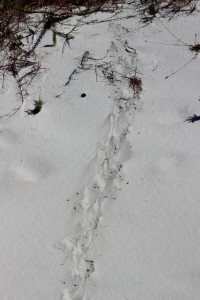
The tracks of the very common armadillo.
Photo: Molly O’Connor
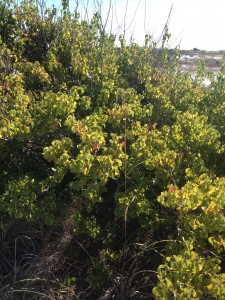
The invasive Chinese Tallow.
Photo: Rick O’Connor
We did see evidence of snake movement this week. There are several species, including the Eastern Diamondback Rattler, which will breed in the fall as well as the spring. I expect to see more activity as the days grow shorter. The dragonflies were very active this month. Actually my wife witnessed two of them consistently pestering a monarch butterfly until the butterfly moved away. I have seen armadillo activity every month of the year so far, this month was no different. The islands seem full of them. This lone Chinese Tallow has formed a small dune where other plants have established and many creatures have taken up residence. At this time there are no other Tallow in the area, and this one will need to be removed before the spread begins. But it is an interesting paradox in that there was an armadillo burrow found here and the sea oats have utilized this dune as well. Invasive species are a problem throughout the state and many have caused with economic or environmental problems – or both! Though this tree has participated in establishing a much needed dune on our hurricane beaten island – native plants do the same and should be favored over non-native. We will have to remove this tree.
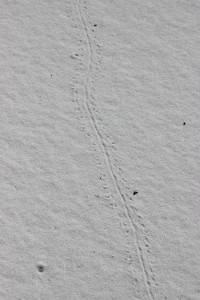
An unknown track; possibly of a turtle hatching.
Photo: Molly O’Connor

This tick was a hitchhiker on our trip through the dunes.
Photo: Molly O’Connor
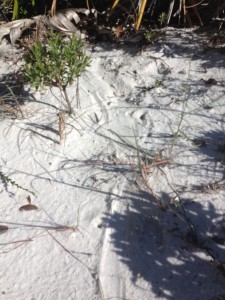
This track was found in the tertiary dune system and could be an adult turtle.
Photo: Rick O’Connor
This small track has the appearance of a “turtle crawl”. It certainly is not a sea turtle, in the middle of the dune field for one thing, but there are several freshwater ponds on our islands that harbor a variety of “riverine turtles”. I know that Cooters, Sliders, and Snappers live on Santa Rosa Island. Terrapins are found in salt marshes. Not sure if this is a turtle but all should be aware that now is hatching time. Many turtle nests began hatching about a month ago and young turtles can be found in a lot of locations. The track in this picture is from a very small animal.
Ticks… yep ticks… It is hard to do a lot of fun outdoor activity in the southeast without encountering these guys. They like to sit on top of tall grass and wait for a mammal to come rummaging through. After each hike we always do a “tick check”. I typically wash my hiking clothes AS SOON AS I GET HOME – in case they are harboring within… I would recommend you do the same. We have been following the “mystery track” since January. This “bed” we have seen each month is in the same location. I thought I had solved the mystery in July when I found armadillo tracks all around it but this month suggest this is not an armadillo. We are not sure what it is – we are leaning towards alligator or otter (both of which can be found – and have been found – on our islands). We will continue to monitor this and hopefully find the sculptor.
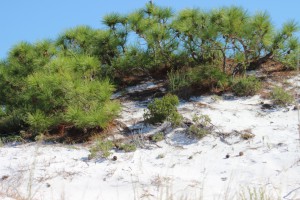
The top of a pine tree within a tertiary dune.
Photo: Molly O’Connor
The seagrass in the sound looked very thick and healthy this month. I have seen horseshoe crab here over the summer and Sea Grant conducted a scallop survey in Santa Rosa Sound and Big Lagoon within Santa Rosa and Escambia counties in August. We found no live scallop but plenty of dead ones – and some of that shell material was relatively “new”. Since scallops only live a year or two this is a good sign. There has been plenty of anecdotal evidence of live ones in the area. REMEMBER THAT IT IS ILLEGAL TO HARVEST SCALLOP WEST OF PORT ST. JOE AND ONLY FROM JUNE 27 TO SEPTEMBER 24 (Learn More). We will continue to conduct these surveys each summer to determine if our area would be a good candidate for a scallop restoration project.
As the days shorten and cool – I am expecting more wildlife activity to begin. Until next month.

by Rick O'Connor | Sep 12, 2015
In the final segment of this 3 part series on worms we will discuss the largest, most commonly encountered members of the worm world… the Annelids.

Neredia are one of the more common polychaete worms.
Photo: University of California Berkley
Annelids differ from the other two groups of worms we have discussed in that they have segmented bodies. They are largest of the worms and the most anatomically complexed. The fluids of their coelomic cavity serve as a skeleton which supports muscle movement and increases locomotion. The annelids include marine forms called Polychaetes, the earthworms, and the leeches.
POLYCHAETES
Polychaetes are the most diverse group of annelids and most live in the marine environment. They differ from earthworms and leeches in that they have appendages called parapodia and do not possess a clitellum. In size they range from 1 mm (0.04”) to 3 m (10’) but most are around 10 cm (4”). Many species display beautiful coloration and some possess toxic spines.
There are 3 basic life forms of polychaetes; free-swimming, sedentary, and boring. The free-swimming polychaetes are found swimming in the water column, crawling across the seabed, or burrowing beneath the sediments. Some species are responsible for the “volcanoes” people see when exploring the bottom of our local bays. Most sedentary polychaetes produce tubes within which they live. Some tubes are made of elastic organic material and others are hard, stony, and calcareous. “Tubeworms” rarely leave their tubes but extend appendages from the tube to collect their food. Most feed on organic material either in the water column or on the seabed but some species collect and consume small invertebrates. There are commensal polychaetes but parasitism is rare. All polychaetes have gills and a closed circulatory system and some have a small heart. As with the other Annelids, polychaetes do have a small brain and are aware of light, touch, and smell; most species dislike light. Reproduction involves males and females who release their gametes in the water where fertilization occurs and drifting larva form.

The tube of a common tubeworm found on panhandle beaches; Diopatra.
Photo: University of Michigan
EARTHWORMS
Aside from parasitic tapeworms and leeches, earthworms are one of the more commonly recognized varieties of worms. Many folks actually raise earthworms for their gardens or for fish bait; a process known as vermiculture. Earthworms differ from polychaetes in that they do not have parapodia but DO possess a clitellum, which is used in reproduction. Though most live in the upper layers of the soil there are freshwater species within this group. They are found in all soils, except those in deserts, and can number over 700 individuals / m2. The number of earthworms within the soil is dependent on several factures including the amount of organic matter, the amount of moisture, soil texture, and soil pH. Scientists are not sure why earthworms surface during heavy rains but it has been suggested that the heavy drops hitting the ground can generate vibrations similar to those of an approaching mole; a reason many think “fiddling” for worms works. Earthworms can significantly improve soil conditions by consuming soil and adding organics via their waste, or castings. Unlike polychaetes, earthworms lack gills and take in oxygen through their skin, one reason why they most live in moist soils. Another difference between them and polychaetes is in reproduction. Aquatic polychaetes can release their gametes into the water where they are fertilized but terrestrial earthworms cannot do this. Instead two worms will entangle and exchange gametes; there are no male and females in this group. The fertilized eggs are encased in a mucous cocoon secreted by the clitellum.
LEECHES
Here is another creepy worm… leeches. Leeches are segmented, and thus annelids, and like earthworms they lack the parapodia found in polychaetes and possess a clitellum for reproduction. Most leeches are quite small, 5 cm (2”) but there is one from the Amazon that reaches 30 cm (12”). Most are very colorful and mimic items within the water, such as leaves. They differ from earthworms in that they are flatter and actually lack a complete coelomic cavity; which most annelids do have. They also possess “suckers” at the head and tail ends.

The ectoparasite we all call the leech.
Photo: University of Michigan
Leeches prefer calm, shallow water but are not fans low pH tannic rivers. If conditions are favorable their numbers can be quite high, as many as 10,000 / m2. They are found worldwide but are more common in the northern temperate zones of the planet; North America and Europe.
Some species feed by using an extending proboscis which they insert and remove body fluids, but most actually have jaws with teeth and use them to rip flesh to cause bleeding, cutting as frequently as 2 slices/second. Those with teeth possess an anesthesia that numbs the area where the bite occurs. Both those with and without teeth possess hirudin, which is an anticoagulant, allowing free-bleeding until the worm is full. Those who feed on blood tend to prey on vertebrates and most species are specific to a particular type of vertebrate. It is known they can detect the smell of a human and will actually swim towards one who is standing still in the water. It takes several hundred days for a leech to digest a full meal of blood and so they feed only once or twice a year. They remove most of the water from the blood once they swallow and require the assistance of bacteria in their guts to breakdown the proteins. They can detect day and night, and prefer to hide from the light. However when it is feeding time they are actually attracted to daylight to increase their chance of finding a host. Vibrations, scent, even water temperature (signaling the presence of warm blooded animals) can stimulate a leech to move towards a potential prey. Leeches, like earthworms, reproduce using a clitellum and develop a cocoon.
Though most find worms a disgusting group of creatures to be avoided, they are actually very successful animals and many species are beneficial to our environment. We hope you learned something from this series and will try and learn more.

by Rick O'Connor | Aug 28, 2015

The round body of a microscopic nematode.
Photo: University of Nebraska at Lincoln
In the first article of this series we discussed the how unpleasant the subject of worms were but how beneficial many species are to our environment. We highlighted the flatworms and this week we will look at the roundworms.
There are a variety of round-shaped worms but the term “roundworm” is usually associated with the Phylum Nematoda; and more commonly called “nematodes”. There are over 10,000 species of nematodes on our planet and they are found in all habitats from the polar region to the tropics and even in deserts. They are found in freshwater and marine systems and are quite common in soils. Within an acre of land there could be literally billions of them.
As the name suggests their bodies are round, not flat, and smooth, not segmented; which separates them from the other two groups we are writing about. Most are very small (< 2.5mm – 0.10”) but some may reach 5cm (2”). Most are carnivorous, some even consume fleas in your yard, but others graze on algae, and others detritus. Many species have a stylet (needle) they use to puncture the cell wall of their prey to consume the internal organic matter. They do not have a developed brain but they do have a series of nerves that run throughout their body. Most are connected to exterior structures associated with the sense of touch, such as setae. There are generally male and female worms in this group and the males are typically smaller in size. However hermaphroditism does exist.
As with most groups of worms, it is the parasites that we really dislike – and there are plenty of parasitic nematodes. They infest a lot of different species. Some live on the outside of plants while others live on the inside. Some are parasitic only at the adult stage, some only as a juvenile, others begin within invertebrates and move to plants as adults. They typically exit one organism through the feces and infest another when the feces is consumed by another.

The life cycle of the human hookworm.
Center for Disease Control
Many species of nematodes have a primary and secondary host life cycle, similar to the flatworms, but others complete the entire life cycle within one organism. Hookworms, a common nematode found in humans, enters the body and feeds on blood cells. The young larva live in the environment and can for a few days in good conditions. When they contact a human they penetrate the skin and move through the circulatory system to the lung. Here they burrow into the bronchioles (airway) and work themselves to the pharynx where they are swallowed by the host and eventually end in the intestine. Within the intestine they feed on blood cells within the intestinal wall. When they reproduce the eggs are released within the feces and enter the environment. If conditions within the environment are good the eggs will hatch and the cycle begins again. Pinworms and whipworms are also parasitic nematodes that infest humans.
Though we dwell on the negative aspect of the parasitic nematodes many species are used indicators of soil health and can give farmers a better idea of the condition of their soil. Suggesting to them what to plant or what they need to do to condition their soil to plant a specific crop.
Next week we will look at the most familiar of the worms – the segmented ones.
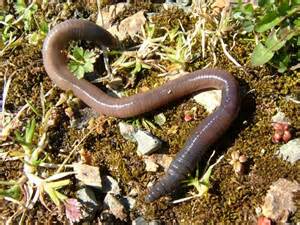
by Rick O'Connor | Aug 21, 2015
I am afraid worms are not the most pleasant topic to write about but few people know much about them. I was once told when I was a student that if you wanted to become known as a scientist study worms, no one else is.
When we hear the term “worm” negative things enter our minds: parasites, disease, uncleanliness to name a few, but many worms are actually beneficial by removing detritus (decaying organic matter) from the environment; the garbage cleaners in a sense. There are at least 10 phyla of worms but this series will focus on the three major groups; flatworms, roundworms, and segmented worms.

The human liver fluke. One of the trematod flatworms that are parasitic.
Photo: University of Pennsylvania
Flatworms include three classes and two of those are parasitic; those are the flukes and tapeworms. Most are very small and emerge in low or no light. The parasitic forms typically live in the gut but can infest other organs of their host organism. There are several species that infest humans but most are specific to a particular group of animals. The flatness of their bodies may have to do with moving materials in and out of the body. Most flatworms lack well develop organ systems so gas exchange occurs through the skin. The more the flat they are, the more surface area they have, the more gas exchange can occur. This is supported by the fact that the larger the flatworm is the more flat they are.
Tubellarians are basically non-parasitic flatworms and are mostly aquatic, many living in the marine environment. Some crawl across the seabed but others can actually swim. As with other flatworms, their digestive tract is incomplete (meaning there is only one opening – the mouth – where food comes in and waste goes out), and this mouth is located half way down their body on the ventral side. Most of these flatworms are carnivorous feeding on small invertebrates and dead organisms. They do have “eyespots” which do not form images but can detect light. Most flatworms are what we call “negatively phototaxic” meaning they sense light but do not like it and will burrow or hide when the sun rises.
Trematoda are what we call flukes and are parasitic. Most are only a few centimeters long but some can reach a meter (3ft.) or more! Flukes have a protective covering on their skin to protect them from the enzymes of their host’s internal environment. Their life cycle requires a second host, meaning that the adult lives in one type of animal but the larval stage occurs in another. Adult flukes live in vertebrates (typically fish), and the secondary hosts are usually invertebrates (typically snails). The eggs (cyst) produced by the adults leave the host organism through their feces. Once in the environment the secondary host consumes them where the larva develop. Eventually the secondary host is consumed by the primary host (fish) where the larva develop into an adult and the cycle begins again. They typically infest the gut but can infest other organs as well.

A tapeworm actually has a round head which posses hooks to attach to the lining of the gut.
Photo: University of Nebraska Omaha
Cestods are one of the more recognized flatworms; these are the tapeworms. Tapeworms lack a digestive tract and most absorb all of their nutrients on through their flat bodies. Like their fluke cousins, tapeworms are endoparasites but almost all of them infest the digestive tract. Like their fluke cousins they require a secondary host, usually an arthropod (insect, spider, or crustacean). With a vertebrate serving as the host organism.
Though there are flukes and tapeworms that infest humans most are found in fish and are specific to that group. The ones that do infest humans require the secondary host cycle described above and, because of sanitary conditions we live in, are not commonly found in the population. This cannot be said for parts of the world where sanitary conditions are not to our standards. As horrible as parasites sound many species of nonparasitic flatworms are beneficial by removing detritus from lakes, rivers, and bays.
Next week… Roundworms.

by Rick O'Connor | Aug 21, 2015
With great interest I read this week that the Orianne Center for Indigo Conservation in central Florida has begun a project to reintroduce the federally listed Eastern Indigo Snake (Drymarchon corais cooper) to the Florida Panhandle; where there have been no verified sightings since the late ‘90s.

The eastern indigo snake is the largest nonvenomous snake in the southeast.
Photo: Molly O’Connor
The Eastern Indigo is the largest nonvenomous snake in the southeast, reaching lengths of eight feet. They prefer sandhills and dry upland areas such longleaf pine forest. The males can patrol areas as large as 3000 acres and are associated with gopher tortoise burrows. Being large snakes they feed on a variety of animals including venomous rattlesnakes. The loss of habitat, along with the decline of gopher tortoises, triggered the decline of this species, and they are rarely seen in the western portions of the range. Indigos are most often found in southern Georgia and peninsular Florida, but sightings at these locations are not common.
The Orianne Center is currently raising young Indigos for release in the Nature Conservancy’s Apalachicola Bluffs and Ravine Preserve. They are planning to release 20 snakes there and an additional 30 in the Conecuh National Forest to support a similar project that Auburn has been doing for the last four years. These snakes are pretty easy to identify. They are iridescent black, usually having an oily sheen appearance to them, with orange coloration on the lower jaw. Oh… and they are big… 8 feet. We are hoping panhandle residents will not be alarmed if they encounter one and allow them to move along. During the last four years of Auburn’s project they have lost quite a few to cars and one visited a youth camp in the National Forest. Alarmed at first the residents soon learned that they were feeding on copperheads in the tool shed and have since loved having these snakes around.
You can read more about this project and the Orianne Center at:
http://blog.nature.org/science/2015/08/17/indigos-return-a-florida-breeding-program-raises-eastern-indigo-snakes-for-reintroduction/


























